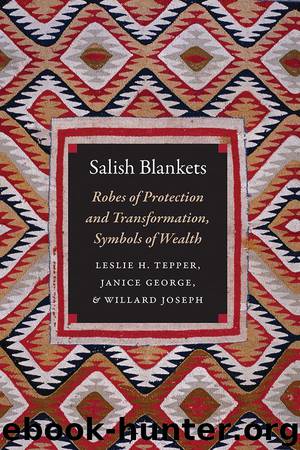Salish Blankets by Leslie H. Tepper & Janice George & Willard Joseph

Author:Leslie H. Tepper & Janice George & Willard Joseph [ Tepper, Leslie H.]
Language: eng
Format: epub
Tags: ART041000 Art / Native American, SOC021000 Social Science / Ethnic Studies / Native American Studies
ISBN: 978-1-4962-0147-8
Publisher: University of Nebraska Press
Published: 2017-05-22T16:00:00+00:00
Early and mid-nineteenth-century Salish textiles illustrate how weavers took advantage of these new materials. Though the designs continued to draw on the traditional geometric vocabulary, wool weavings took on new color combinations and greater visual complexity. Finely spun threads in bright colors provided an opportunity to incorporate contrast within a small motif or to highlight elements of the design.
It is clear that historical weavers understood the techniques of producing and using thinner threads. A number of the earliest blankets in museum collections, for example the textiles from the Peabody Museum at Harvard collected around 1819, are woven from finely spun yarn.5 By the mid-nineteenth century, blankets had geometric shapes outlined in one color and filled in with another. Weavers also created a third color tone by alternating weft throws of threads of similar value, such as red and orange. This type of color combination, particularly when used in short columns of analogous hues, would make the colors appear distinctive when the textile was seen close up but blended when it was viewed from a distance, or perhaps when observed by firelight in a ceremonial setting.
An effective use of this subtle color application is found on two long, narrow belts collected between 1838 and 1842 during the Charles Wilkes U.S. Exploring Expedition (figure 30). As in most Salish designs, the weaver has played with colors on a white background. Sections of red and blue triangles alternate with segments of triangles woven in yellow and green. The overall effect is to break up the pattern line into blocks while keeping a single narrow zigzag line as a connecting white background. Many of the yellow triangles are outlined in red, a technique also found on some blankets.
Download
This site does not store any files on its server. We only index and link to content provided by other sites. Please contact the content providers to delete copyright contents if any and email us, we'll remove relevant links or contents immediately.
| African-American Studies | Asian American Studies |
| Disabled | Ethnic Studies |
| Hispanic American Studies | LGBT |
| Minority Studies | Native American Studies |
Cecilia; Or, Memoirs of an Heiress — Volume 1 by Fanny Burney(32495)
Cecilia; Or, Memoirs of an Heiress — Volume 2 by Fanny Burney(31909)
Cecilia; Or, Memoirs of an Heiress — Volume 3 by Fanny Burney(31893)
The Great Music City by Andrea Baker(31758)
We're Going to Need More Wine by Gabrielle Union(19003)
All the Missing Girls by Megan Miranda(15779)
Pimp by Iceberg Slim(14434)
Bombshells: Glamour Girls of a Lifetime by Sullivan Steve(14022)
For the Love of Europe by Rick Steves(13591)
Talking to Strangers by Malcolm Gladwell(13291)
Norse Mythology by Gaiman Neil(13279)
Fifty Shades Freed by E L James(13187)
Mindhunter: Inside the FBI's Elite Serial Crime Unit by John E. Douglas & Mark Olshaker(9263)
Crazy Rich Asians by Kevin Kwan(9223)
The Lost Art of Listening by Michael P. Nichols(7453)
Enlightenment Now: The Case for Reason, Science, Humanism, and Progress by Steven Pinker(7273)
The Four Agreements by Don Miguel Ruiz(6701)
Bad Blood by John Carreyrou(6583)
Weapons of Math Destruction by Cathy O'Neil(6215)
